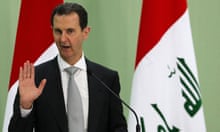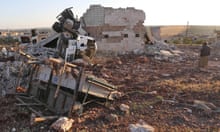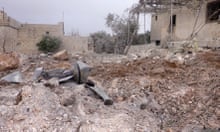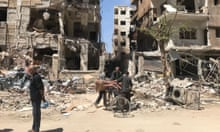The US military has launched a cruise missile attack on a Syrian airfield in response to Bashar al-Assad regime’s use of chemical weapons this week, marking the first time the US has become a direct combatant against the Syrian regime.
The US move drew an angry response from Russia, which described the strike as an “aggression against a sovereign state in violation of international law”.
The Russian foreign ministry has since announced that it was suspending a deal with the US to exchange information about military flights to avoid incidents in the crowded skies over Syria. Moscow has also called for a meeting of the UN security council to discuss the strikes.
Syrian officials said at least seven people were killed and nine wounded in US missile attack.
Russia’s foreign minister said no Russian service personnel were hurt in the strike. Speaking during a trip to Uzbekistan, Sergei Lavrov said the strike was launched on an “absolutely made-up pretext”, adding: “It reminds me of the situation in 2003 when the United States and Britain, along with some of their allies, attacked Iraq.”
He said Russia would demand Washington explain why it conducted the strikes. “I hope this provocation will not lead to irreparable damage [to US-Russian ties],” Lavrov said.
Donald Trump, who for years signalled he was comfortable with Assad remaining in power, abruptly switched course after seeing images of children gassed to death in Idlib province after Assad used chemical weapons against Syrian civilians.
The US strike saw 59 Tomahawk cruise missiles launched from the guided-missile destroyers USS Ross and USS Porter in the eastern Mediterranean.
An airbase at Shayrat, near Homs, was targeted, signalling a limited initial engagement on a target the military said was used to launch the chemical attack.
Although the US targeted some of Syria’s air defenses, it did not do so largely beyond Shayrat or in a sustained barrage, as it would typically do before launching a concerted air campaign. Instead, the Pentagon said, it attacked “aircraft, hardened aircraft shelters, petroleum and logistical storage, ammunition supply bunkers, air defense systems, and radars” at the airfield.
Russian state TV aired footage claiming to show the damage from the US strikes at the Syrian airbase. It showed craters and pockmarks left by explosions and said nine Syrian air force jets had been destroyed.
Though Trump lacked congressional and international authorisation for the strike, prominent US politicians immediately gave him political cover.
The president said on Thursday night at his Mar-a-Lago resort that he had ordered a “targeted military strike on the airfield in Syria from where the chemical attack was launched”.
After a frantic day of consultation with his military advisers, including the defense secretary, James Mattis, and the national security adviser, HR McMaster, Trump said it was a “vital national security interest” of the US to prevent “the spread and use of deadly chemical weapons” after previous efforts to change Assad’s behavior “had failed, and failed very dramatically”.
Trump also called on the international community to “join us in seeking to end the slaughter and bloodshed in Syria and also to end terrorism of all kinds and all types”, leaving it unclear whether the US objective was retaliation for the chemical assault, destruction of Assad’s chemical stockpiles or a push to oust Assad from power.
For its part, the Pentagon said the strike “was intended to deter the regime from using chemical weapons again”.
Vladimir Putin’s spokesman, Dmitry Peskov, said in a statement carried by Russian news agencies that the president believed the US had carried out the strikes under a “far-fetched pretext”. Russia has argued that the death of civilians in Khan Sheikhun resulted from Syrian forces hitting a rebel chemical arsenal there, but the Guardian visited the attack site and found no evidence for this claim. Dozens of civilians, including 10 children, were killed, apparently by a chemical attack on Khan Sheikhun, in a region held by rebels who oppose Assad’s regime.
On Friday, sources told the Guardian US intelligence officials believed Russian personnel were at Shayrat airbase when the chemical agent was loaded on to a Syrian jet. They have not established whether the Russians knew it was happening.
The base covers an area of more than 8 sq km (3 sq miles) and has two runways and dozens of buildings, silos and storage facilities.
The sources said on both occasions a Russian Sukhoi aircraft was monitored by ground radar and aerial reconnaissance flying over the town. Flashes had been detected on the ground indicating that ordnance had been dropped.
Trump had already warned that his view had been changed by the shocking images of children. The attack happened at 8.40pm eastern standard time (4.40am in Syria) while Trump was hosting his Chinese counterpart, Xi Jinping, at Mar-a-Lago in Florida.
In 2013, Assad’s forces used chemical weapons, including sarin and chlorine, killing more than 1,000 people. President Barack Obama threatened military action over Assad’s use of sarin, an illegal weapon, but the US Congress balked and Russia intervened to make a deal in which Assad would hand over stockpiles of weapons.
The Tomahawks used on Friday are sophisticated missiles that can be retargeted while in the air. Syria’s formidable, Russian-supplied air defences, largely along the Mediterranean coast, have long prompted US military officials to warn against attacking Assad.
Since Russia sent aircraft, troops and personnel to bolster Assad in late 2015, the Syrian president’s fortunes have improved dramatically, and he has retaken territory from the beleaguered and fractious armed opposition. The Russian presence has raised the stakes dramatically for US military planners, as the prospect of accidentally killing Russian personnel and sparking a larger war with a nuclear power reduces the US room for manoeuvre.
However, according to the Pentagon spokesman Capt Jeff Davis, the US military notified Russian forces before the strike, using a communications channel set up to ensure US pilots who attacked Islamic State targets in eastern Syria did not accidentally come into conflict with their Russian counterparts.
It is likely Russia would have passed the warning on to its Syrian allies. The US has roughly 1,000 troops in Syria, who may be at risk as a result of the strike.
“We are assessing the results of the strike,” Davis said. “Initial indications are that this strike has severely damaged or destroyed Syrian aircraft and support infrastructure and equipment at Shayrat airfield, reducing the Syrian government’s ability to deliver chemical weapons.”
Davis said the airbase had been used to store chemical weapons used by the regime until 2013, when a deal was struck with the US and Russia to remove its declared arsenal. He said it was used to deliver the chemical weapons dropped on Khan Sheikhun, but could not confirm whether any chemical weapons were still at the site. However, he stressed that the targets were chosen carefully to avoid the risk of hitting those weapons.
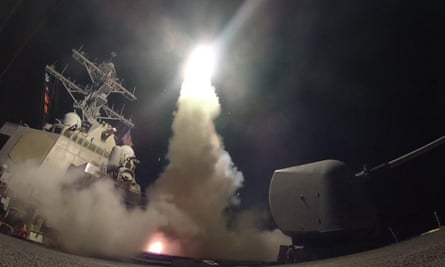
“The places we targeted were the things that made the airfield operate. It’s the petroleum facilities, it’s the aircraft radar, what they use for takeoff and landing, as well as air-defense radar,” Davis said. “It’s the sites that are specific to making it operate, as well as hangars and aircraft themselves.”
For years, defense analysts have warned the US against attacking Assad without a plan for what it seeks to achieve or what a post-Assad Syria might look like.
Davis said precautions were taken to avoid killing Russian personnel on their compound at Shayrat, citing the timing of the attack and the choice of targets unlikely to have people inside. All the aircraft attacked were Syrian, he said.
Neither the US Congress nor the UN have authorized war against Assad. Mary Ellen O’Connell, an international law scholar at the University of Notre Dame, said Trump did not have a legal basis for military action.
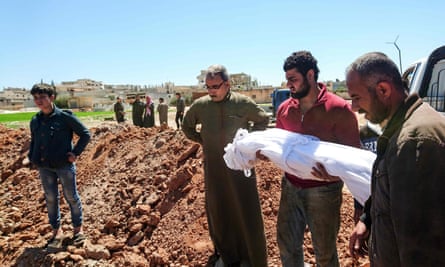
“Under international law, he has zero right to attack Assad. It would be a reprisal attack. You won’t find any international law specialists who will find a legal right to carry out a reprisal,” O’Connell said.
For years, Trump rejected any attack on Assad as a strategic folly, despite repeated chemical assaults of the sort that prompted Thursday’s missile strikes. After Russia’s intervention in the conflict, Trump said rival Hillary Clinton’s openness to strikes against Assad’s forces were inviting conflict with Russia. Just days ago, his secretary of state and UN ambassador made statements indicating Trump was prepared to let Assad – who in November called Trump a “natural ally” – remain in power.
But earlier on Thursday, after Trump’s public anger at Assad for the chemical assault, the secretary of state, Rex Tillerson, said there was “no role for [Assad] to govern the Syrian people” and called on Russia, where Tillerson will travel next week, to “consider carefully” its sponsorship of the Syrian dictator.
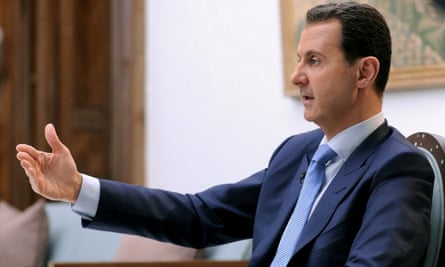
Tillerson suggested “steps are under way” to rally an international coalition to remove Assad diplomatically, a position long thwarted by Moscow and Beijing.
Longtime Syria hawks – and Trump critics – John McCain and Lindsey Graham rallied behind Trump in the pursuit of an attack they have urged for years.
Trump and the military “sent an important message the United States will no longer stand idly by as Assad, aided and abetted by Putin’s Russia, slaughters innocent Syrians with chemical weapons and barrel bombs”, the two Republican senators said in a joint statement.
The senior Democrat on the Senate foreign relations committee, Ben Cardin, joined in support, but said: “Any longer-term or larger military operation in Syria by the Trump administration will need to be done in consultation with the Congress.
“Furthermore, it is the president’s responsibility to inform the legislative branch and the American people about his larger policy in Syria, as well as the legal basis for this action and any additional military activities in that country.”
